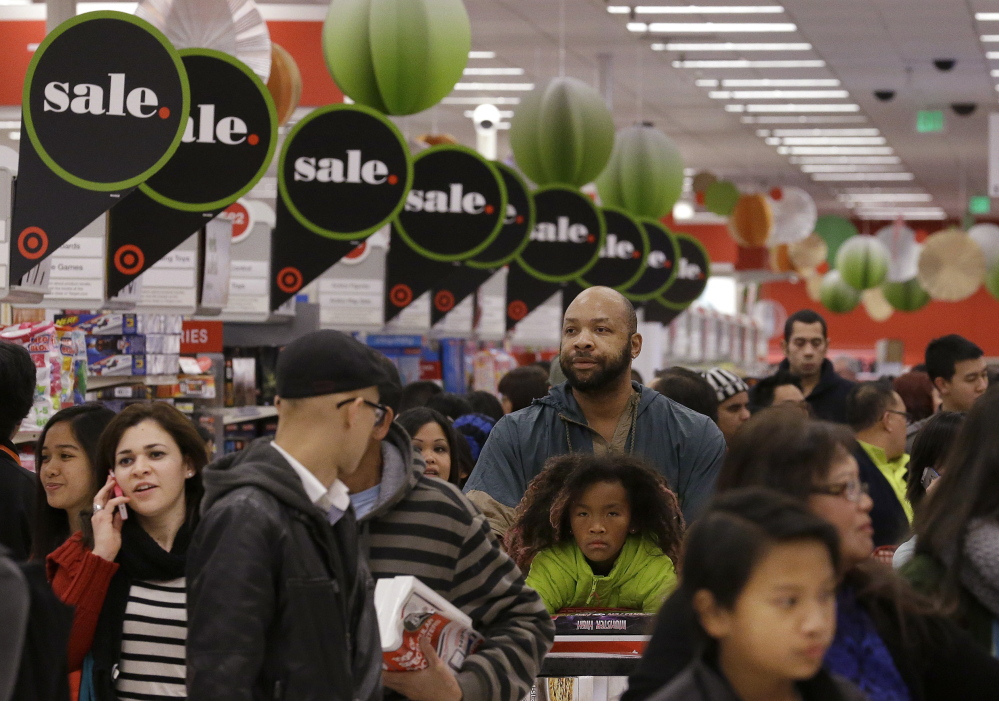Falling gas prices. Soaring stock market. Unemployment at a six-year low.
All signs point to a successful holiday shopping season. Despite the economic tail winds, though, retailers are finding themselves having to work to get shoppers into stores.
Why? Five years into the economic recovery, most Americans still are struggling.
Gas prices may be hovering at a four-year low, but Americans are paying more for food, health care and other costs. Unemployment is falling, too, but wage growth has been stagnant. And even though the stock and housing markets have improved, Americans haven’t changed their deal-hungry shopping habits.
“Retail therapy is out the window for most Americans,” said Ken Perkins, president of RetailMetrics LLC, a research firm.
Not that this holiday season is expected to be a dud. In fact, the National Retail Federation forecasts holiday sales will grow 4.1 percent to $616.9 billion – the highest increase since 2011. But retailers already have had to resort to discounting to get shoppers into stores.
Heavy discounting eats into profits. For example, over the past weekend, online sales rose 18.7 percent, but the average order value was $112.86, down 5.4 percent for the same period a year ago because of promotions, according to IBM Digital Analysts Benchmark, which tracks sales at 800 websites.
Reflecting the tough environment, major department stores, including Macy’s, J.C. Penney and Kohl’s, reported sales shortfalls in the quarter preceding the holiday shopping season. Discounters like Target and Wal-Mart turned in better-than-expected sales, but acknowledged that shoppers are cautious.
Here are three reasons many Americans plan to spend conservatively this holiday season even though economic factors have improved:
SLOW WAGE GROWTH
Paychecks have barely stayed ahead of inflation since the recession ended more than five years ago.
Average hourly wages, adjusted for inflation, rose just 0.3 percent in September from a year earlier. And many Americans, who once worked full time now have part-time jobs. There are still nearly 2 million fewer people working full time in December 2007, when the Great Recession began.
That’s one reason shoppers might not spend briskly during the holiday despite the fact that the U.S. jobless rate hit 5.8 percent last month, down 1.5 percentage points from a year ago.
HIGHER COSTS
Gas prices have fallen 20 percent from a year ago to $2.81. While that puts an average of $50 a month into the pockets of American households, they’re still grappling with higher costs on lots of other necessities like food and health care.
Overall food prices are up 1.7 percent from a year ago, according to the latest Consumer Price Index. Meat prices are up 8.5 percent, while egg prices rose 6.7 percent.
SHOPPERS WANT DEALS
Shoppers may feel a little better about the overall economy, but they’re still focused on a deal. And they’re still sticking to lists.
Send questions/comments to the editors.



Success. Please wait for the page to reload. If the page does not reload within 5 seconds, please refresh the page.
Enter your email and password to access comments.
Hi, to comment on stories you must . This profile is in addition to your subscription and website login.
Already have a commenting profile? .
Invalid username/password.
Please check your email to confirm and complete your registration.
Only subscribers are eligible to post comments. Please subscribe or login first for digital access. Here’s why.
Use the form below to reset your password. When you've submitted your account email, we will send an email with a reset code.